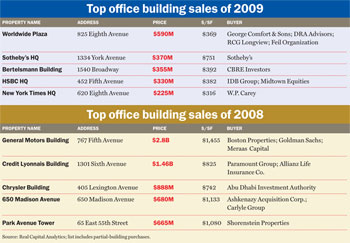Trending
 What’s going on with Ryan Serhant’s Central Park Tower penthouse listing?
What’s going on with Ryan Serhant’s Central Park Tower penthouse listing? Elliman broker Tracy Tutor comes forward with Oren Alexander claim
Elliman broker Tracy Tutor comes forward with Oren Alexander claim New reports expand reach of Alexander brothers sexual assault allegations
New reports expand reach of Alexander brothers sexual assault allegations Investors scoop up dev site near Pompano Beach casino for $29M, amid near record South Florida multifamily pipeline
Investors scoop up dev site near Pompano Beach casino for $29M, amid near record South Florida multifamily pipelineNowhere to go but up?
Optimists make their case for a commercial sales market upswing

Click the chart for a larger versionƒDeclarations that Manhattan’s commercial real estate market has “hit bottom” are usually met with a response somewhat akin to a boy crying wolf: It has been uttered so often that it has lost much of its resonance. But with the catastrophe that was 2009 over, some say that at least part of Manhattan’s commercial real estate market is ready for an upswing. Could it be true this time? The Real Deal parsed through some of the arguments — for and against — whether the market has hit bottom.
Lending security
By almost any statistical measure, 2009 was an abysmal year for Manhattan commercial real estate sales, one of the worst on record. Sales volume for 2009 was a fraction of what it was just two years ago, and prices have plummeted almost 40 percent (even more in some sectors). In addition, the top five “mega” deals in Manhattan barely qualify as mega when compared to 2008.
“Yes. It can only get better in 2010,” said Eastern Consolidated’s chief economist, Barbara Byrne Denham, who recently released a report that was just one of several that painted an irrefutably bleak picture of New York’s commercial property sales market over the past 12 months.
“It seems like over time, there is a little more security in the lending market and the buying market,” Denham added.
According to a report from Eastern Consolidated, total sales volume for the year was $5.5 billion — less than a quarter of 2008’s $23.6 billion, and an even smaller fraction of the $62.8 billion in 2007.
New York got hit harder than some other major cities; New York office buildings saw larger annual price declines than those in San Francisco and Washington, D.C. Office prices in New York fell 38.1 percent over the past four quarters, according to a report from the rating agency Moody’s.
What’s more, last year’s average building sales price of $4.4 million represents a drop of 65 percent from the $12.4 million average in 2007, according to Massey Knakal, which specializes in building sales.
Even the year’s largest office deals were draped in discouragement. Last year’s top five sales, according to research firm Real Capital Analytics, included: Worldwide Plaza at 825 Eighth Avenue; Sotheby’s headquarters at 1334 York Avenue; the Bertelsmann Building at 1540 Broadway; HSBC’s headquarters at 452 Fifth Avenue; and the New York Times headquarters on Eighth Avenue.
A comparison of these deals with the top deals of 2008 puts the pain of last year in perspective. Three of the top transactions in 2008 were completed with a per-square-foot price that was well over $1,000, but the top price per square foot for transactions in 2009 was just $751.
With 2010 starting at such a low point, Massey Knakal cofounder and chairman Robert Knakal may have summed it up best when he wrote in a recent column: “Basically, 2010 should suck a lot less!”
Psychological threshold
The decade is over. It’s the end of the aughts.
“There is something about being in the threshold outside of 2009. It’s a psychological barrier that we have crossed over,” noted Denham.
“We called the bottom two weeks ago,” Real Capital Analytics managing director Dan Fasulo said in January.
Knakal, however, offers caution while agreeing that psychology certainly plays a role. Massey Knakal research shows that there are an estimated 15,000 properties in New York City with negative equity, and approximately $165 billion of debt on those properties, he noted.
This deleveraging process will likely result in losses in the $30 to $40 billion range, and will be most acutely felt in 2011 and 2012, as the 2006 and 2007 loans mature, Knakal said.
The result, according to Knakal, is expected to be a downward pressure on prices. “Psychologically we are feeling better, but we have a significant deleveraging process to go through, and that process is not going to happen overnight,” Knakal said in an interview.
Momentum from 2009
The Eastern Consolidated report shows that the fourth quarter of 2009 saw a slight increase in the volume of multifamily property sales from the two previous quarters. Average prices per square foot in commercial buildings increased in the second half of 2009.
Although there were only three significant office building transactions in the fourth quarter, the activity is still grounds for optimism, especially coming out of such a dismal year. “The fact that these deals are getting done at the end of the year makes people more optimistic,” said Denham. “There is so much money waiting on the sidelines.”
For Class A office buildings, RCA’s Fasulo is predicting transaction activity to increase almost immediately, and said there are signs that a number of deleveraged REITs and foreign investors are ready to dive into the Manhattan office market.
“For good property there is significant demand, possibly too much demand, and that is why we think prices will come back in 2010,” he said.
But whether prices will actually rise in 2010 seems like an open question, according to Knakal. He predicts that volume will return, but that prices will stay static until unemployment peaks and starts reversing.
“The volume will increase 40 percent in 2010 and that is very positive, but from a value perspective not very much is going to change between 2009 and 2010. If you are an owner of a building, I don’t think things are going to be much better at all,” he said.
Could New York follow other foreign-market rebounds? Other foreign commercial capitals — most notably London — are returning to form. Fasulo said part of the reason for London’s resiliency over the last 12 months is due to trading of its large pool of midsize buildings.
Despite its fame for marquee mega-buildings, New York has a large pool of these midrange buildings, too — and there are signs that even more credit will be opening up to increase volume for this sector. A recent Jones Lang LaSalle survey of 60 banks showed that more than half of them said that in 2010 they would be willing to lend $50 million or more toward a single property purchase, double what most were willing to do last year.
Defining improvement
It seems clear that depth perception for a market in free fall is never an easy or simple proposition, even for the most astute observers. But based on the aggregate pain inflicted in 2009 and glimmers of hope in market data, it seems that things can only get better. What remains to be seen is how much better.
